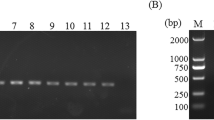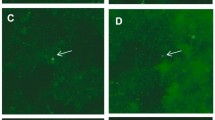Abstract
Background: The implementation of cost-effective intervention strategies for zoonotic protozoa relies on the development of sensitive and accurate diagnostic methods. We carried out a study to evaluate the accuracy of a PCR method for the detection of Cryptosporidium spp. oocysts in fecal samples from cattle.
Methods: Fecal samples were spiked with different numbers of oocysts and the limit of detection of the method was determined. Two methods of DNA extraction were assessed: glass beads and freeze-thawing using liquid nitrogen. A nested PCR approach was developed targeting the Cryptosporidium SSU rRNA and TRAP-C2 genes. Agreement between the diagnosis of Cryptosporidium spp. at the SSU rRNA and TRAP-C2 loci was quantified using the κ-coefficient.
Results: Compared with the freeze-thawing method, the glass beads method was found to be a better way of extracting DNA from Cryptosporidium oocysts (sensitivities were 83 and 100%, respectively). The limits of detection for glass beads and freeze-thaw were low, 1 and 10 oocyst/g fecal samples, respectively. Forty-six percent of the field samples previously classified as negative for Cryptosporidium parvum by the floatation-concentration and enzyme-linked immunosorbent assay methods showed DNA with the PCR protocol.
Conclusion: Primers for SSU rRNA are more successful in producing an amplification than primers for the TRAP-C2 gene which makes the former PCR protocol the approach of choice for detecting Cryptosporidium parvum oocysts in field samples.






Similar content being viewed by others
References
Barwick RS, Levy DA, Craun GF, et al. Surveillance for waterborne-disease outbreaks: United States, 1997–1998. MMWR CDC Surveill Summ 2000; 49: 1–35
Xiao L, Herd RP. Infection patterns of Cryptosporidium and Giardia in calves. Vet Parasitai 1994; 55: 257–62
Sischo WM, Atwill ER, Lanyon LE, et al. Cryptosporidia on dairy farms and the role these farms may have in contaminating surface water supplies in the northeastern United States. Prev Vet Med 2000; 43: 253–67
Wade SE, Mohammed HO, SL Schaaf. Prevalence of Giardia sp., Cryptosporidiumparvum, and Cryptosporidium muris (C. andersoni) in 109 dairy herds in southeastern New York State. Vet Parasitol 2000; 93: 1–11
Georgi JR, Georgi ME. Parasitology for veterinarians. 5th ed. Philadelphia (PA): WB Saunders, 1990: 267–9
Anusz K, Mason P, Riggs M, et al. Detection of Cryptosporidium parvum oocysts in bovine feces by monoclonal antibody capture enzyme-linked immunosorbent assay. J Clin Microbiol 1990; 28: 2770–4
Siddons A, Chapman P, Rush B. Evaluation of an enzyme immunoassay kit detecting cryptosporidium in faeces and environmental samples. Clin Pathol 1992; 45: 479–82
Rosenblatt J, Sloan L. Evaluation of an enzyme-linked immunosorbent assay for detection of Cryptosporidium spp. in stool specimens. J Clin Microbiol 1993; 31: 1468–71
Kehl KSC, Cicirello H, Havens PL. Comparison of four different methods for detection of Cryptosporidium species. J Clin Microbiol 1995; 33: 416–8
Lindergard G, Wade SE, Schaaf S, et al. Detection of Cryptosporidium oocysts in soil samples by enzyme-linked immunoassay. Vet Parasitol 2001; 94: 163–76
Fayer R. Cryptosporidium and cryptosporidiosis. Boston (MA): CRC Press, 1997
Morgan U, Thompson R. PCR detection of Cryptosporidium: the way forward? Parasitol Today 1998; 14: 241–5
Wiedenmann A, Krüger P, Botzenhart K. PCR detection of Cryptosporidium parvum in environmental samples: a review of published protocols and current developments. J Ind Microbiol Biotechnol 1998; 21: 150–66
Wu Z, Nagano I, Matsuo A, et al. Specific PCR primers for Cryptosporidium parvum with extra high sensitivity. Mol Cell Probes 2001; 14: 33–9
McLauchlin J, Amar C, Diaz P, et al. Molecular epidemiological analysis of Cryptosporidium spp. in the United Kingdom: results of genotyping Cryptosporidium spp. in 1,705 fecal samples from humans and 105 fecal samples from livestock animals. J Clin Microbiol 2000; 38: 3984–90
Johnson DW, Pieniazek NJ, Griffin DW, et al. Development of a PCR protocol for sensitive detection of Cryptosporidium oocysts in water samples. Appl Environ Microbiol 1995; 61: 3849–55
Berthelet M, Whyte L, Gréer C. Rapid, direct extraction of DNA from soils for PCR analysis using polyvinylpolypyrrolidone spin columns. FEMS Microbiol Lett 1996; 138: 17–22
Mohammed HO, Wade SE, Schaaf S. Risk factors associated with Cryptosporidium parvum infection in dairy cattle in southeastern New York State. Vet Parasitol 1999; 83: 1–13
Arrowood M, Sterling C. Isolation of Cryptosporidium oocysts and sporozoites using discontinuous sucrose and isopycnic percoll gradients. J Parasitol 1987; 73: 314–9
Zhu G, Marchewka M, Ennis J, et al. Direct isolation of DNA from patient stool samples for polymerase chain reaction detection of Cryptosporidium parvum. J Infect Dis 1998; 177: 1443–6
Corpet F. Multiple sequence alignment with hierarchical clustering. Nucleic Acids Res 1988; 16: 10881–90
Morgan U, Constantine C, Forbes D, et al. Differentiation between human and animal isolates of Cryptosporidium parvum using rDNA sequencing and direct PCR analysis. J Parasitol 1997; 83: 825–30
Laberge I, Griffiths M. Prevalence, detection and control of Cryptosporidium parvum in food. Int J Food Microbiol 1996; 31: 1–26
Sluter SD, Tzipori S, Widmer G. Parameters affecting polymerase chain reaction detection on waterborne Cryptosporidium parvum oocysts. Appl Microbiol Biotechnol 1997; 48: 325–30
Webster K, Smith H, Giles M, et al. Detection of Cryptosporidium parvum oocysts in faeces: comparison of conventional coproscopical methods and the polymerase chain reaction. Vet Parasitol 1996; 61: 5–13
Chapman P, Rush B, McLauchlin J. An enzyme immunoassay for detecting Cryptosporidium in faecel and environmental samples: the Pathological Society of Great Britain and Ireland. J Med Microbiol 1990; 32: 233–7
Ungar B. Enzyme-linked immunoassay for detection of Cryptosporidium antigens in fecal specimens. J Clin Microbiol 1990; 28: 2491–5
Spano F, Crisanti A. Cryptosporidium parvum: the many secrets of a small genome. Int J Parasitol 2000; 30: 553–65
Le Blancq SM, Khramtsov NV, Zamani F, et al. Ribosomal RNA gene organization in Cryptosporidium parvum. Mol Biochem Parasitol 1997; 90: 463–78
Acknowledgements
This study was funded by a grant from the USGS through the Water Resources Institute, Cornell University (NY01-B-1841), and from the USDA (grant no. 98-38420-5803).
Author information
Authors and Affiliations
Corresponding author
Rights and permissions
About this article
Cite this article
Lindergard, G., Nydam, D.V., Wade, S.E. et al. The Sensitivity of PCR Detection of Cryptosporidium Oocysts in Fecal Samples Using Two DNA Extraction Methods. CNS Drugs 7, 147–153 (2003). https://doi.org/10.1007/BF03260031
Published:
Issue Date:
DOI: https://doi.org/10.1007/BF03260031




